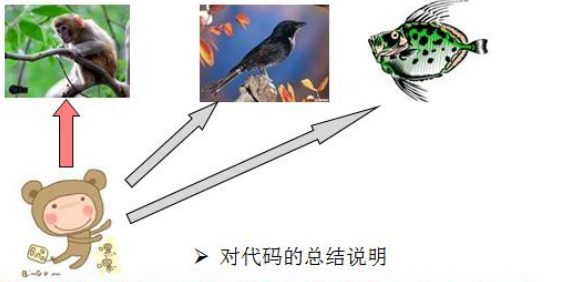继承
Go语言的设计之初,就不打算支持面向对象的编程特性,因此Go不支持面向对象的三大特性之一——继承。但是Go可以通过组合的思想去实现 “继承”。- 继承是面向对象的三大特性之一,继承是从已有的类中派生出新的类,新的类能吸收已有类的数据属性和行为,并能扩展新的能力。
Go语言里的“继承”体现如一个结构体拥有另一个结构体的的所有字段和方法,并在此基础上,定义新的字段和方法。
代码
import "fmt"type Person struct {Name stringAge int
}func (p Person) Introduce() {fmt.Printf("大家好,我叫%s,我今年%d岁了。\n", p.Name, p.Age)
}type Student struct {PersonSchool string
}func (s Student) GoToTheClass() {fmt.Println("去上课...")
}func main() {student := Student{}student.Name = "小明"student.Age = 18student.School = "太阳系大学"// 执行 Person 类型的 Introduce 方法student.Introduce()// 执行自身的 GoToTheClass 方法student.GoToTheClass()
}
输出
大家好,我叫小明,我今年18岁了。
去上课...
接口

直接看代码
package main
import ("fmt"
)//Monkey结构体
type Monkey struct {Name string
}//声明接口
type BirdAble interface {Flying()
}type FishAble interface {Swimming()
}func (this *Monkey) climbing() {fmt.Println(this.Name, " 生来会爬树..")
}//LittleMonkey结构体
type LittleMonkey struct {Monkey //继承
}//让LittleMonkey实现BirdAble
func (this *LittleMonkey) Flying() {fmt.Println(this.Name, " 通过学习,会飞翔...")
}//让LittleMonkey实现FishAble
func (this *LittleMonkey) Swimming() {fmt.Println(this.Name, " 通过学习,会游泳..")
}func main() {//创建一个LittleMonkey 实例monkey := LittleMonkey{Monkey {Name : "悟空",},}monkey.climbing()monkey.Flying()monkey.Swimming()}
输出
悟空 生来会爬树..
悟空 通过学习,会飞翔...
悟空 通过学习,会游泳..
总结
当A结构体继承了B结构体,那么A结构体就自动的继承了B结构体的字段和方法,并且可以直接使用。
当A结构需要扩展功能,同时不希望去破坏继承关系,则可以去实现某个接口即可,因此我们可以认为:实现接口是对继承机制的补充。





)



】132 - GMSL2 协议分析 之 GPIO/SPI/I2C/UART 等通迅控制协议带宽消耗计算)

对企业的重要性)







